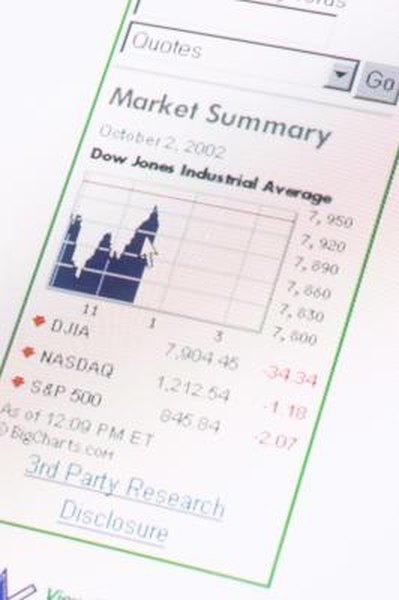Stock Market Points Vs. Percent
News accounts often discuss how the stock market performed in points.
Hemera Technologies/Photos.com/Getty Images
On the financial news channels, they love to talk about points -- such as: "The Dow was up 50 points today." Unfortunately, points have a different value depending on whether someone is talking about stock indexes or share prices. Making a calculation to turn those points into a percentage will make the value of the points easier to understand.
Stock Index Points
With stock indexes such as the Dow Jones industrial average or the S&P 500, a point is just a whole number in the index value. If the Dow Jones index increases from 13,000 to 13,001, it gained one point. Discussions about stock index points use whole numbers to describe increases and dips, and ignore the fractional values after the decimal point. To understand what the points signify, you need to have an idea of the current value of a stock index. For example, if the Dow Jones industrial average was at 13,180 and the S&P 500 was at 1,420, a point would mean a much different value change for the Dow index when compared to the S&P 500 index.
Stock Share Points
For individual stocks, points indicate whole dollar price changes. If someone states that IBM is up 5 points, it means the IBM share price is $5 higher. With stocks, a point is a dollar on a $20 stock, and a point is a dollar on a $500 stock. The term "points" gets widespread use, so a news commentator using "points" usually doesn't feel the need to differentiate whether a point is a dollar on a stock, or the whole number of a stock index. To understand what a point means relative to a given stock or index, you need to know the current value of the stock or the index you're following.
Percent Math
The designated number of points divided into the value of the underlying stock or index price produces a percentage change. If IBM is up 5 points from $100 per share, that means that it's up $5, and the stock gained 5 percent. If the S&P 500 is up 5 points from 1,420, the stock index gained 0.35 percent. Percentages of change are always calculated from the starting value. Using the percent change makes comparisons understandable. For example, if the Dow is up 130 points from a starting value of 13,180 for the day, and the S&P 500 has gained just 14 points from a starting point of 1,420, both stock indexes are up about 1 percent.
Time Frames
The use of "points" to describe stock index or share price gains is usually confined to short-term results, such as for the day or week. Investors who keep an eye on the market will understand the value of the points relative to the underlying index or stock. For longer time frames such as year-to-date or 12-month returns, the financial news reports will often provide those results in percentage terms. In the investing world, day-to-day results are counted in points and annual results get converted to percentage gains and losses.
References
Writer Bio
Tim Plaehn has been writing financial, investment and trading articles and blogs since 2007. His work has appeared online at Seeking Alpha, Marketwatch.com and various other websites. Plaehn has a bachelor's degree in mathematics from the U.S. Air Force Academy.

